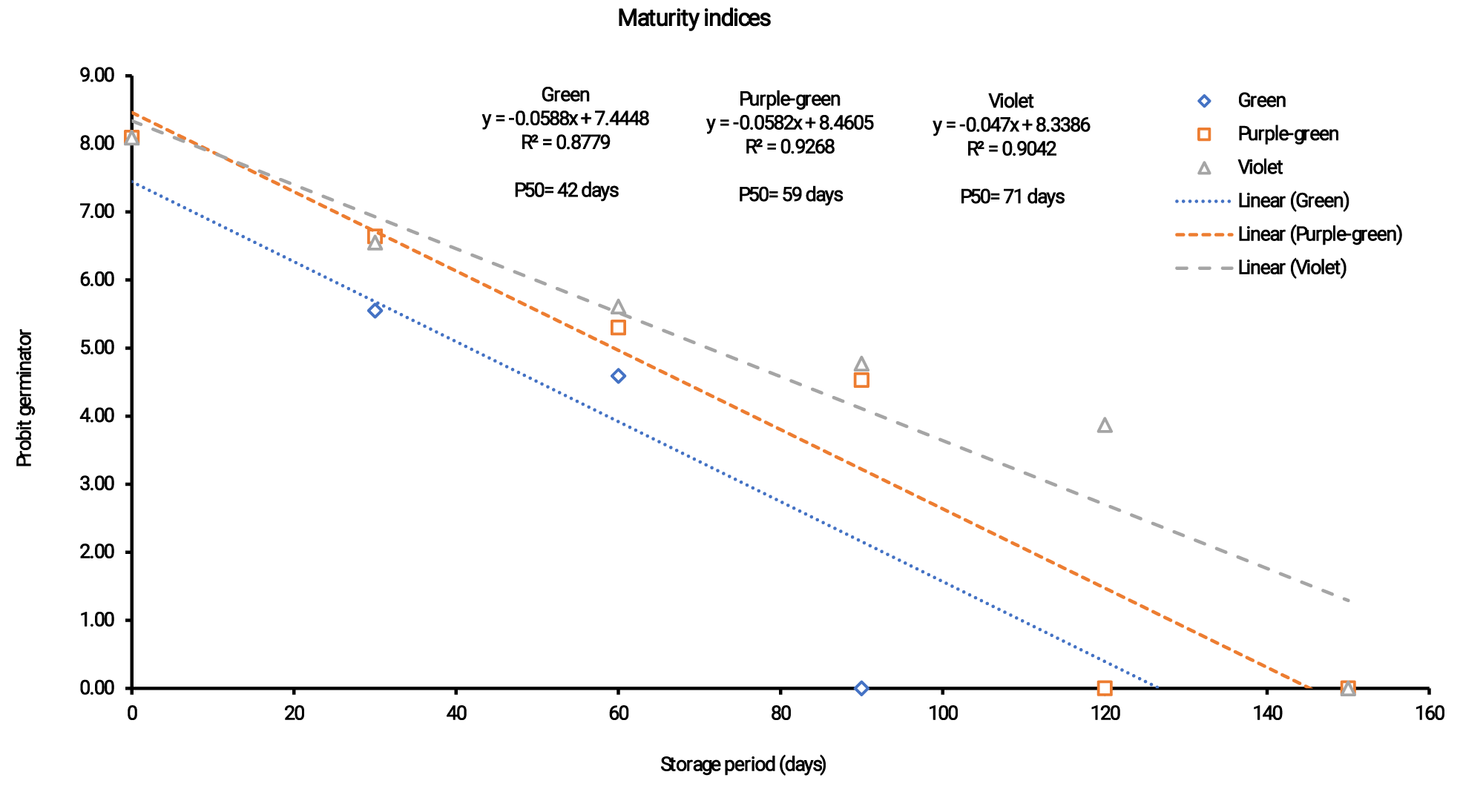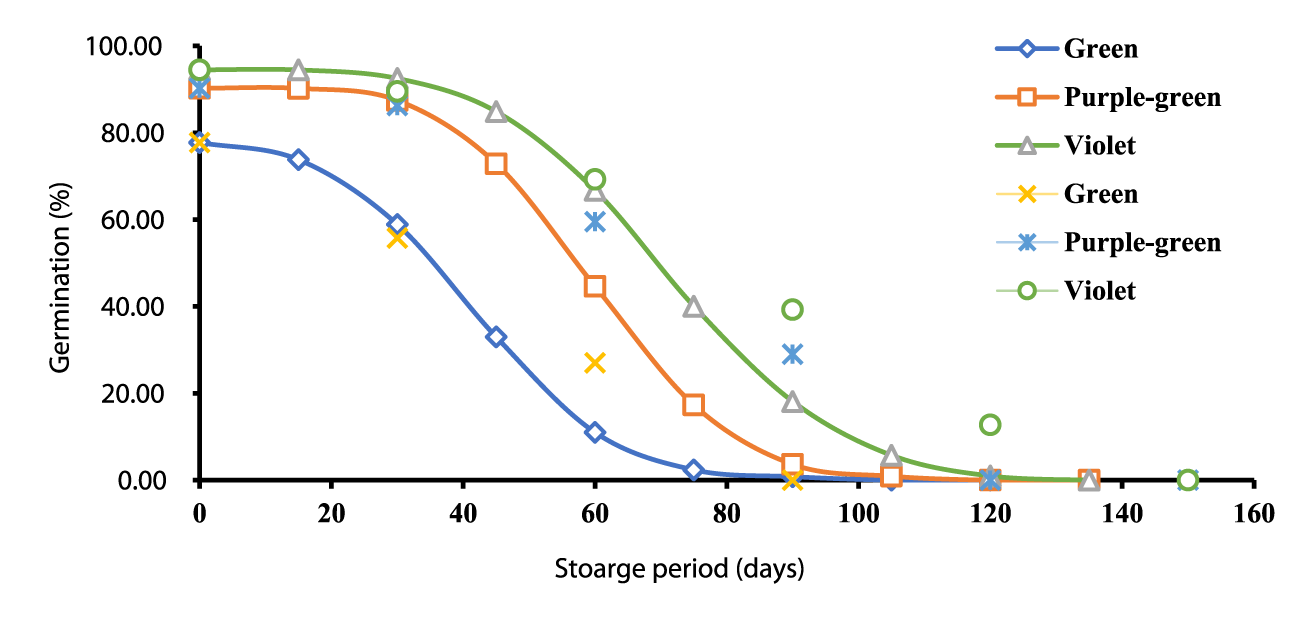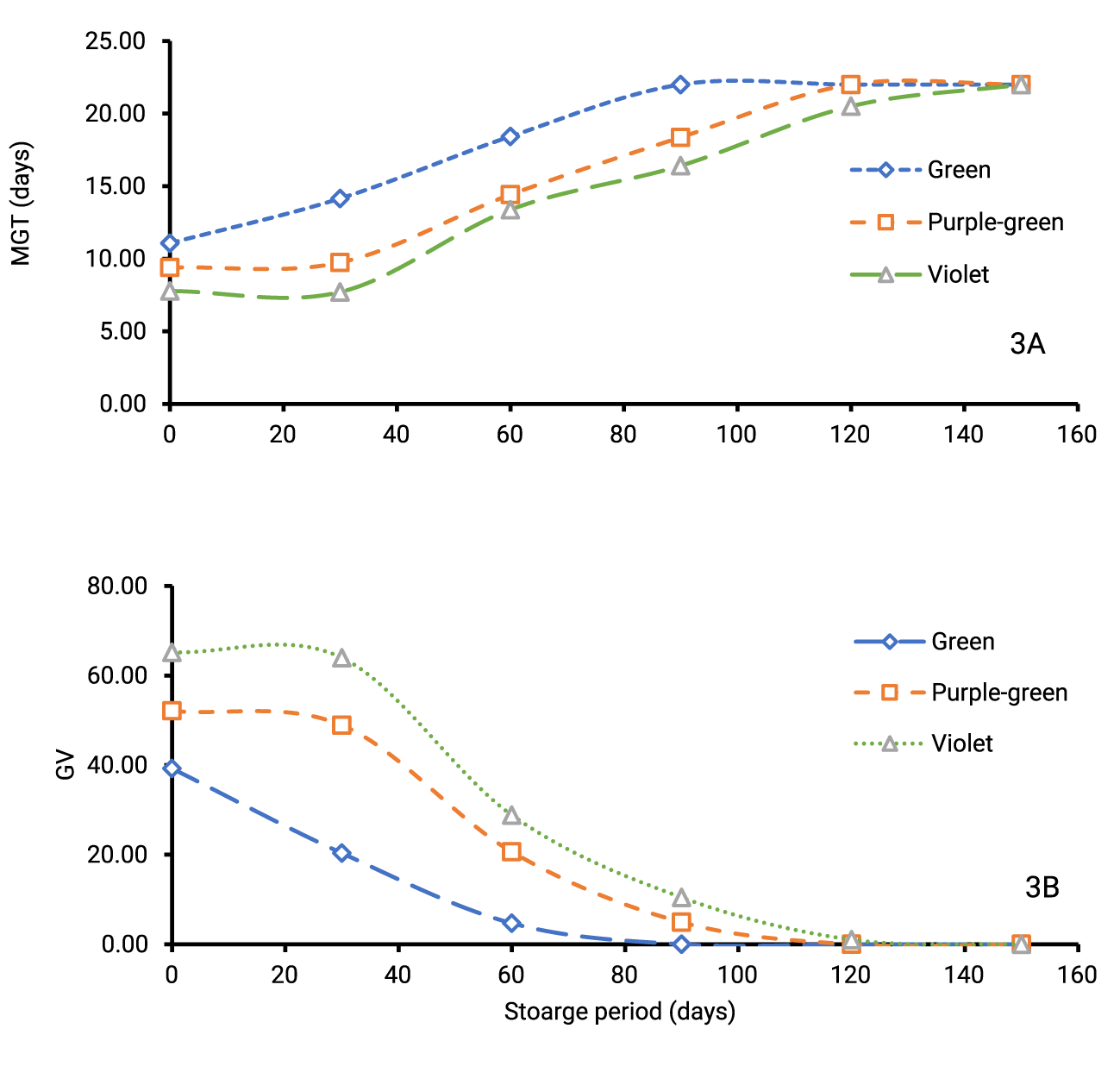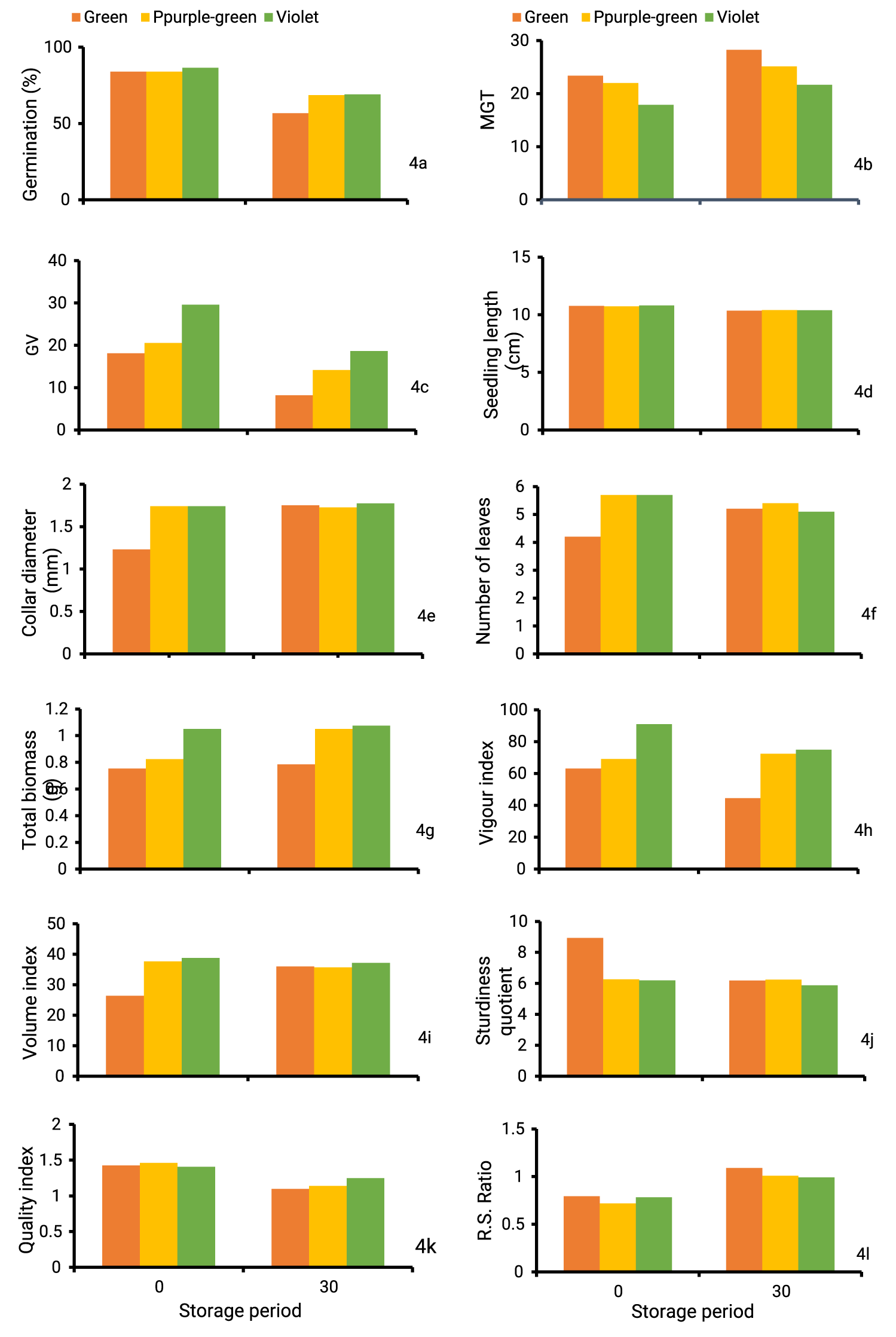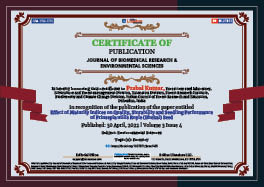Environmental Sciences . 2022 April 30;3(4):453-456. doi: 10.37871/jbres1465.
Effect of Maturity Indices on Quality, Storability and Seedling Performance of Prinsepia utilis Royle (Bhekal) Seed
Prabal Kumar*, Devendra Kumar and Sanjay Singh
Abstract
Background: Prinsepia utilis Royle is a wild woody oil yielding shrub of Rosaceae, commonly known as bhekal. Plant whole parts are all precious; their root, stem, leaf, fruit, and seed oil are used as medicine. Its tender stems, leaf and fibrous root decoction, are used in toothache and throat inflammation. Besides all this, the plant is also commonly used as bio-fence, apple grafting, a substitute for soap and cosmetics, and performing different ritualistic/holistic practices.
Material and methods: The fruits were collected from Chakrata forest Division (Uttarakhand), India, in mid-May 2017. Fruits are collected directly from branches and separated according to their color into three sub-lots, i.e., green, purple-green and violet. Seeds were tested under controlled conditions for their viability and vigour at different storage intervals viz 0 days (fresh), 30, 60, 90, 120 and 150 days. In the nursery, seeds were sown as fresh 0 and 30 days after collection to see the storage effect on seedling performance. Seeds were sown in four replications of 100 seeds of each lot in a nursery bed prepared with compost, sand, and soil (1:1:1).
Results: Fresh seeds obtained from violet fruit showed 94.50% germination, followed by purple-green and green fruit with 90.25 and 77.75%, respectively. The germination declined during storage in all types of fruit colors. It is evident from the survival curve that violet fruit retained a maximum period of mean viability (P50) (71 days) as compared to purple-green fruits (59 days) and green fruit (42 days). The violet exhibited a higher mean germination percentage (50.88) after 150 days of storage period as compared to purple-green fruit (44.17) and green fruit (26.75). The seedling performance was significantly affected by fruit colors. The violet seeds significantly exhibited good values of as compared to green and purple, green seeds.
Conclusion: Seeds obtained from violet fruits may be preferred for longer storage of seeds and remaining fruit seed color should be avoided for storage purposes.
Introduction
Prinsepia utilis Royle is a wild woody oil yielding shrub of Rosaceae which has been commonly known as bhekal. It is a perennial deciduous, moderate-size shrub attaining a height of 1.5 m to 4 m which profuse in upright and lateral directions to form large thickets. The species is native of tropical and temperate Asia grows varying in habitats, including the hill slopes to the vertical cliffs and mountain valleys to the barren land. Plant deep taproot system, make this shrub suitable to combat soil erosion and land sleep on degraded barren land. Significantly, the plants have the unique capacity to enjoy light, happiness is wet, cold-cool climate, snow-frost resistant, drought-enduring, strong adaptive capacity to the environment. Plant whole parts is all precious, its root, stem, leaf, fruit, seed oil is use as a medicine. Its tender stems, leaf and fibrous root decoction used in toothache and throat inflammation. Besides all this, the plant is also commonly used as bio-fence, apple grafting, and substitute for soap and cosmetics and for performing different ritualistic/holistic practices. Its diseases free and termite resistant wood is used by rural people for making the tools handle, musical instruments, toys, house commodity and other items. It is considered one of the most useful multipurpose shrub species and almost all parts of the plant have one or more uses. Seeds are short lived and loose viability very fast [1]. Fruit do not mature simultaneously. In bhekal, the fruit start maturing during mid-May in Chakrata, Uttarakhand and all fruits shed within a month. Fruit at different stage of maturity can be seen during fruiting season. The collection of bhekal seed of desired maturity is difficult as the fruit grows in bunch. Thus, the fruits collected are of different colors containing seeds at different stages of maturity. The physiological maturity of seeds is major factor, which directly affect the vigour of nursery stock. The fruit color, smell and taste are some of characters, which indicate fruit maturity. Color of fruit usually changes from green to various shades of yellow, brown or gray and this may be accompanied by hardening of the pericarp of dehiscent or woody fruits. Final moisture content in the seed depends on species and the external environment. Recalcitrant seeds maintain relatively high moisture content typically around 25-30% while orthodox at 5-10% during maturation. P. utilis like intermediate seed retains very high moisture during maturation. As the fruit and seed become mature then abscission zone is formed. The time of abscission and location of the abscission zone vary according to the type of species. As abscission is under hormonal control it is likely that environmental conditions such as weather condition or stress may influence time of abscission. Abscission of whole fruits may occur at the base of the fruit or at the base of the pedicle or peduncle. Knowledge of late maturity events of bhekal fruits and seeds is the basis for developing reliable maturity indices which in turn determine the most appropriate time of collection.
Knowing the stage and time of maturity of seeds is essential for collecting the abundant quantity of healthy and vigorous seeds. Physiologically immature seeds or pre-harvest sprouting is a constrain problem resulting in poor seed quality [2-5]. It has been often recommended to collect dark-coloured fruits to obtain maximum germination in Pongamia pinnata [6-9] in Jatropha curcas [10-12] in Jamun [13] in Aisandra butyracea [14] in Prunus cerasoides Don D [15] in Gmelina arborea [16] in Allophylus edulis [17] in Solanum melongena L [18,19] and in Pinus kesiya [20].
Perusal of literature showed that no in-depth study on physical indices of seed maturity was available. Present studies were undertaken to investigate physical indices of seed maturity in terms of germination and storability.
Materials and Methods
Collection, extraction and processing of seeds
The fruits were collected from Chakrata forest Division (Uttarakhand) India during mid-May 2017 situated between 30°31' to 31°3'N latitude and 77°42' to78° 05'E longitude. Mean minimum and maximum temperature of -4 ± 5°C and 25 ± 5°C and humidity between 10-70% was recorded during the experimental period. Fruits collected directly from branches and separated according to their colour into three sub-lot i.e., green, purple-green and violet. Fruits were kept in gunny bags at ambient temperature (28 ± 5°C) for one day to soften the pulp. All the green, and purple-green fruits became soft within one day while some of the green fruits (20%) remained firm and were removed from the lot. Hence these firm seeds were not included for test. Seeds were depulped completely from endocarp by macerating into cotton bags (30 x 30 cm). Cleaned seeds were shade dried upto Equilibrium Moisture Content (EMC) for 3 days. Identity of seed lots were maintained after drying for a day, initial germination and percent moisture content was determined as per International Seed Testing Association [21].
Germination study
Seeds were stored in open containers at ambient room temperature. Seeds were tested under controlled conditions for their viability and vigour at different intervals of storage viz 0 days (fresh), 30, 60, 90, 120 and 150 days. Germination tests were conducted between blotting germination paper (BP) using four replications of 100 seeds, incubated at 25 ± 2°C and 90 ± 5°C RH. (Relative Humidity). Germination data were recorded daily up to 21 days and seed was considered germinated when radicle became 1 cm in length.
In nursery, seeds were sown as fresh 0 and 30 days after collection to see the effect of storage on seedling performance. Seeds were sown in four replications of 100 seeds of each lot in a nursery bed prepared with compost, sand, and soil (1:1:1). Germination data were recorded for up to 35 days. A seed was considered germinated when hypocotyl emerged 1 cm, above the ground. The seedling was uprooted after 35 days of sowing and was washed thoroughly. Ten seedlings were randomly selected from each replication were taken for further conservation of total seedling length (cm) collar diameter (mm) number of leaves, total biomass (g) Biomass was measured in grams up to two decimals by electronic balance. Collar diameter was measured by a vernier caliper up to two decimals. The volume index was calculated by multiplying of diameter (mm2) and height (cm). Vigour index [22] quality index [23] sturdiness quotient [24] and root shoot ratio (on dry weight basis) were calculated. Biomass was taken on dry weight basis at 80 ± 1°C for 72 hours.
Speed of germination (MGT days) was calculated as described by [25] while Germination Value (GV) was calculated as described by [26]. The pattern of decline in germination in each seed lot was subjected to probit analysis [27] and survival curves were drawn [28] between expected germination and storage period (days) for estimating the mean viability period i.e., p50 (time taken to 50% death of seeds) as described by [29,30]. The germination percentage, time taken to complete germination in terms of Mean Germination Time (MGT days) and Germination Value (GV) were analyzed through ANOVA using SPSS package. The p-value < 0.05 was taken as significant.
Results and Discussion
Effect of physical indices of seed maturity (fruit color) on germination of fresh seeds under controlled condition
There was a significant difference in mean germination time and germination value of seeds obtained from all three colors (green, purple-green and violet). However, a non-significant difference in germination percentage between the violet and purple-green seeds was observed (Table 1). Violet seeds (94.50) and purple-green seeds (90.25) exhibited a significantly maximum germination percentage compared to green seeds with 77.75% (Table 1). Violet fruit exhibited significantly lowest MGT (7.78 days) followed by purple-green and green with 9.39 and 11.06 days, respectively (Table 1). Violet seeds exhibited the highest Germination Value significantly (GV) (63.19) followed by purple, green and green seeds with 52.10 and 39.27.
| Table 1: Effect of method of seed collection on germination of fresh seeds under a controlled environment. Values are means of replications and each replication contain 100 seeds. Values in parenthesis are arc sin transformed. | |||
| Parameters | Method of seed collection | ||
| Green | Purple-green | Violet | |
| Germination (%) | 77.75 (61.97)b | 90.25 (71.94)a | 94.50 (78.44)a |
| MGT (days) | 11.06a | 09.39b | 07.78c |
| GV | 39.27c | 52.10b | 65.19a |
| In each ro In each row, values not followed by the same letter are significantly different (p > 0.05) Effect of physical indices of seed maturity (fruit colour) on germination of stored seeds under controlled condition. |
|||
Survival curves
Seeds obtained from different fruit colors (green, purple-green and violet) were stored for 150 days under ambient room temperature in open containers. Fresh fruit obtained from violet fruit showed 94.50% germination, followed by purple-green and green fruit with 90.25 and 77.75%, respectively (Table 1). The germination declined during storage in all types of fruit colors. The rate of decline was higher in green fruit followed by purple-green and violet fruits up to 60 days of storage with 50.75, 30.75 and 25.25, respectively. The green fruit failed to show germination up to 90 days of storage, while the purple-green fruit and violet fruit showed a decline in germination up to 61.25 and 55.25% up to 90 days of storage. However, when seeds were stored for a longer period (up to 120 days), all remaining seeds failed to show germination except for violet seeds. The rate of decline in germination percentage was lowest in violet seeds between these two periods. However, up to 150 days of storage leads to failing germination in all kinds of seeds. The germination percentage obtained after different storage periods were transformed to probit values. These values were subjected to probit analysis against days of storage for the ambient condition with the help of a regression equation (Figure 1) expected probit germination was calculated. The expected probit germination was transformed into expected germination and resulting survival curves are presented in figure 2. It is evident from the survival curves that the flatter gradient, the greater variation between seeds and viability period. The gradient is steeper in seeds collected from the green fruit and exhibits rapid seeds deterioration compared to the remaining fruits.
Mean viability period (p50)
The pattern of decline in germination percentage is shown in figure 1. It is evident from the survival curve that violet fruit retained a maximum period of mean viability (p50) (71 days) as compared to purple-green fruits (59 days) and green fruit (42 days) (Table 2) (Figure 2). It is obvious from curves that seeds obtained from violet fruits retained maximum mean viability compared to those obtained from the purple-green and green fruits.
| Table 2: Effect of maturity indices on mean germination percentage, mean MGT and mean Germination Value (GV) during storage. Seed lots were stored for 150 days in open container under ambient room temperature (annual mean maximum 30 ± 2°C and min 18 ± 2°C). Seeds performance was taken at 0 days (fresh), 30, 60, 90, 120 and 150 days of storage under controlled environment. Values are means of four replications and each replication contain 100 seeds. Values are in parenthesis are arc sin transformed. | |||
| Parameters | Effect of maturity indices (fruit colour) | ||
| Green | Purple-green | Violet | |
| Germination (%) | 26.75 (23.60)c | 44.17 (37.33)b | 50.88 (44.29)a |
| MGT (days) | 18.27c | 15.98b | 14.63a |
| GV | 10.72c | 21.10b | 28.25a |
| P50 (days) | 42 | 59 | 71 |
| In each row, values not followed by the same letter are significantly different (p > 0.05). | |||
Mean germination
Mean germination percentage declined with the storage period. The violet exhibited a higher mean germination percentage (50.88) after 150 days of storage period as compared to purple-green fruit (44.17) and green fruit (26.75) (Table 2) (Figure 2). MGT was significantly increased (Figure 3a) while Germination Value (GV) decreased with the storage period (Figure 3b). Violet fruits exhibited a significant lowest mean MGT (14.45 days) as compared to purple-green fruits (15.98 days) and green fruit (18.27 days). Violet exhibited a significantly maximum mean GV (28.25) compared to purple-green and green fruits with 21.10 and 10.72, respectively. Green fruit exhibited the poorest mean GV compared to all (Table 2). Violet fruit remained viable for a longer time (p50 71 days) than the seeds obtained from purple-green fruits (p50 59 days) and green fruits (p50 42 days) (Table 2).
Effect of physical indices of maturity (Seedling performance)
Effect of physical indices of maturity (fruit color) on germination and seedling performance of fresh seeds in nursery: Fresh seeds obtained from green, purple-green and violet fruit were shade dried in the laboratory and seeds were sown for evaluation of seeds and seedlings parameters in the nursery.
There was a nonsignificant difference in germination percentage of seeds obtained from all three colors and ranged between 84 - 86.50% (Figure 4). However, there was a significant difference in Mean Germination Time (MGT) and Germination Value (GV) in all three colors of seeds. The lowest mean germination time was exhibited by violet seeds (17.88 days), followed by purple-green (22.01 days) and green (23.40 days). A similar trend was obtained concerning GV. It was highest in violet seeds (29.61), followed by purple-green (20.57) and green seeds (18.13).
The seedling performance was significantly affected by fruit colors. The violet seeds significantly exhibited good values of collar diameter (1.74 mm) total biomass (1.05 g), vigor index (90.93) and volume index (38.79) as compared to green and purple green seeds (Figure 4). There was a no significant difference among tested seeds regarding seedling length, quality index and root shoot ratio. The insignificant highest seedling length was exhibited in violet seeds (10.81 cm) followed by purple-green (10.72 cm) and green seeds (10.77 cm). A similar trend was recorded for the number of leaves. The highest number of leaves occupied by both violet and purple-green seeds (5.70) was significantly followed by green seeds (4.20). The insignificant maximum quality index was found in purple-green seeds (1.46) followed by violet seeds and green seeds with 1.41 and 1.43 respectively. However, the maximum root shoot ratio was shown in green seeds (0.79) followed by violet (0.78) and purple-green seeds (0.72) respectively. A significant difference was observed in tested seeds for sturdiness quotient; the highest sturdiness quotient was obtained by green seeds (8.74).
The good value of sturdiness quotient was exhibited by purple, green and violet seeds with 6.26 and 6.19 respectively. However, an insignificant difference was observed between green and purple-green in terms of total biomass and vigor index, while purple-green and violet seeds exhibited insignificant differences in terms of collar diameter and volume index (Figure 4).
Effect of physical indices of maturity (fruit color) on germination and seedling performance during storage: Seeds obtained from green, purple-green and violet fruits were shade dried in the laboratory for up to 4 days to reach an Equilibrium Moisture Content (EMC) of 7%. Seeds were then subjected to storage treatment in a 200 µ thick polythene bag and kept in an airtight plastic container at ambient room temperature for 30 days, respectively. After desired incubations, seeds were sown in the nursery to evaluate seed and seedling performance. The effect of fruit color during seed storage on germination and seedling performance was depicted in figure 4. A significant decline was observed in germination percentage, germination value and vigor index, whereas mean germination time was significantly increased in seeds obtained from all three colors during 30 days of storage. No significant effect of storage was observed on seedling performance in terms of seedling length, the number of leaves, collar diameter, total biomass, sturdiness quotient, volume index, quality index and root shoot ratio during the storage (Figure 4). The germination percentage and germination value were significantly declined while the Mean Germination Time (MGT) was significantly increased during storage in all three colors (Figures 4a-c). The violet seeds exhibited a significantly higher germination percentage (69.00), followed by purple-green (68.5) seeds.
However, there was a nonsignificant difference between purple-green and violet seeds. The green seeds exhibited a significantly poor germination percentage (56.75) compared to purple-green and violet fruit seeds (Figure 4a). The green seeds exhibited an insignificant lower mean germination percentage (70.37) as compared to violet (77.75) and purple-green (76.25) seeds.
The Mean Germination Time (MGT) was significantly increased during storage in all three colors. The significant lowest MGT was observed in violet seeds (21.65 days) followed by purple green (25.14 days) and green (28.27 days) after 30 days of storage (Figure 4b). There was a significant difference among the entire three colors in mean MGT. The violet seeds showed significantly the lowest mean MGT (19.76 days) followed by purple-green and green seeds with 23.57 and 25.83 days, respectively. The Germination Value (GV) was also significantly declined with storage. The significant highest GV was exhibited by violets seeds (18.66) as compared to purple-green (14.15) and green seeds (8.18) after 30 days of storage (Figure 4c). Green exhibited significantly poor GV as compared to others. There was a significant difference in the mean Germination Value (GV) of tested fruit seeds colors. The significantly highest mean germination value was obtained in violets seeds (24.14) compared to purple, green and green with 17.35 and 13.59, respectively (Figure 4). However, there was a nonsignificant difference between green and purple-green seeds.
A nonsignificant reduction was observed in seedling performance in terms of seedling length (cm), and sturdiness quotient. However, a significant decline was observed in terms of total biomass and vigor index. The number of leaves, collar diameter, and volume index and root shoot ratio showed insignificant increment. Violet seeds exhibited significantly maximum seedling length (10.40 cm) followed by purple-green (10.50 cm) and green (10.35 cm) after 30 days of storage. However, there was a nonsignificant difference between all three colors (Figure 4d). The purple-green seed exhibited maximum mean seedling length (10.61 cm) as compared to violet (10.60 cm) and green seeds (10.56 cm). However, a nonsignificant difference was observed in all three colors. During the storage, the Collar Diameter (CD) was increased in all three colors. Violet seeds exhibited maximum collar diameter (1.87 mm) as compared to green (1.75 mm) and purple-green (1.72 mm). However, there was a nonsignificant difference in all three colors after 35 days of storage (Figure 4e) but there was a significant difference in mean collar diameter in green (1.49 mm) from violet (1.80 mm) and purple-green (1.70 mm) seeds. The violets exhibited maximum collar diameter followed by purple, green and green. All three color seeds show an increased number of leaves during the storage period, but any color did not show a significant difference compared to fresh seeds' color. The violet seeds exhibited the maximum number of leaves (7.1) followed by purple-green (5.8) and green (5.7). However, there was a significant difference in the mean number of leaves. The violet seeds significantly exhibited the maximum number of leaves (6.35) followed by purple, green and violet with 5.75 and 4.95 respectively (Figure 4f).
Green and purple-green seeds showed a nonsignificant reduction in total biomass during the storage period (Figure 4g), while the violet seeds showed a slight increment. Violet seeds exhibited maximum total biomass (1.08 g), followed by purple-green (0.73 g) seeds and green seeds (0.70 g). However, there was an insignificant difference among all three colors after 30 days of storage. The maximum mean biomass was significantly exhibited by violet seeds (1.06 g) as compared to purple-green (0.76 g) and green (0.73 g) seeds. However, green and purple-green seeds showed an insignificant difference. A significant reduction was observed in vigor index in all three colors with storage period (Figure 4h). Violet seeds exhibited the slowest reduction in vigor index (74.93) as compared to purple-green (49.47) and green seeds (39.85) after 30 days of storage. However, there was an insignificant difference between green and purple-green seeds. The highest mean volume index was significantly exhibited by violet seeds (39.07), followed by purple-green and violet with 37.36 and 31.19. The root-shoot ratio was increased in all three colors during the storage. The maximum ratio was exhibited by green seeds followed by purple-green and violet seeds. However, there was a nonsignificant difference among entire colors in both stored and mean root-shoot ratio values (Figure 4i). Fresh seeds of violet showed higher seedling length, the number of leaves, collar diameter, total biomass, vigor index, volume index, quality index and good values of sturdiness quotient than green and purple-green fruits. Stored seeds followed the same trend (Figure 4). However, violet performed best with respect to mean germination and seedling performance compared to green and purple-green seeds. From the present study, it can be recommended that bhekal fruits of any color capable of softening within a day can be collected if they are required immediately for sowing, but if seeds are to be stored for a brief period before sowing in nursey violet fruits may be collected.
In contrast to our studies, some researchers [31-33] reported that post-harvest of maturity indices stored better than dark fruit color. Similar findings have been reported [6-8]. They observed a rapid and significant loss of germination in seeds obtained from unripe fruits (Green and yellow). It seems that bhekal seeds attain full maturity when the fruit turns violet as it showed significantly lower MGT and maximum GV performed best in storage.
Conclusion
Based on the experiment, it is concluded that bhekal fruits of any color capable of softening within a day, will give better germination and viability. However, the seeds procured from violet fruit significantly perform better as compared to seeds obtained from green and purple-green fruits. So, the seeds obtained from violet fruits may be preferred for longer storage of seeds and the remaining fruit seed color should be avoided for storage purposes.
Acknowledgment
The authors are thankful to the director of FRI, Dehradun for providing necessary facilities during the course of the study. The first author is grateful to Late Mr. Prakash Singh Bhakuni, for his physical help during the whole experiment.
References
- Bhagat S, Singh O. A note on germination and longevity of Prinsepia utilis Royle seed. Indian For. 1989;113(5):442-443. doi: 10.36808/if/1989/v115i6/9068.
- Wang X, Zheng H, Tang Q. Early harvesting improves seed vigour of hybrid rice seeds. Sci Rep. 2018 Jul 23;8(1):11092. doi: 10.1038/s41598-018-29021-5. PMID: 30038290; PMCID: PMC6056454.
- Finch-Savage WE, Bassel GW. Seed vigour and crop establishment: extending performance beyond adaptation. J Exp Bot. 2016 Feb;67(3):567-91. doi: 10.1093/jxb/erv490. Epub 2015 Nov 19. PMID: 26585226.
- Fu H, Cao DD, Hu WM, Guan YJ, Fu YY, Fang YF, Hu J. Studies on optimum harvest time for hybrid rice seed. J Sci Food Agric. 2017 Mar;97(4):1124-1133. doi: 10.1002/jsfa.7838. Epub 2016 Jul 13. PMID: 27283044.
- Lee HJ, Kim H, Kim OW. Optimal harvest timing for maximizing grain yield and whole kernel ratio of short-grain rice. Transactions of the ASABE. 2016;59(2):745-750. https://tinyurl.com/38ramc99
- Ferreira EI, Pereira MD, Macedo ARD, Soares ER. Effect of fertilization on the physiological maturation of sesame seeds. Pesquisa Agropecuária Tropical. 2017;47: 202-210. doi: 10.1590/1983-40632016v4745715.
- Hay FR, Whitehouse KJ. Rethinking the approach to viability monitoring in seed genebanks. Conserv Physiol. 2017 Mar 4;5(1):cox009. doi: 10.1093/conphys/cox009. PMID: 28361000; PMCID: PMC5356937.
- Tetteh R, Aboagye LM, Darko R, Osafo EA. Effect of maturity stages on seed quality of two tomato accessions. African Crop Science Journal. 2018;26(2):237-244. doi: 10.4314/acsj.v26i2.6.
- Srimathi P, Mariappan N, Sundaramoorthy L, Sudhakar K. Studies on floral phenology, fruit and seed maturation and harvest index based on fruit colour in Pongamia pinnata (L.) Pierre. African Journal of Plant Science. 2013;7(11):513-520. doi: 10.5897/AJPS2013.1077.
- Gurunathan N, Srimathi P, Paramathma M. Influence of size polymorphism on seed and seedling quality of Jatropha curcas. Madras Agricultural Journal. 2009;96(1/6):62-66. https://tinyurl.com/5n6v33y8
- Kathiravan M. Seed production, processing, testing and storage techniques in Jatropha (Jatropha curcas Linn.) (Doctoral dissertation, Tamil Nadu Agricultural University Coimbatore). 2004.
- Kaushik N, Deswal RPS, Sharma KD. Maturity indices in Jatropha curcas. Seed Research. 2001;29(2):223-224. https://tinyurl.com/5n78uur3
- Srimathi P, Sasthri G, Venkatasalam EP. Effect of fruit colour on fruit, seed and seedling quality characters in Jamun. Progressive Horticulture. 2001;33(1): 27-31.
- Singh RP, Tewari A, Shah S, Tewari B. Seed maturity indices in Aisandra butyracea--a multipurpose tree species of lower Himalaya. J Environ Biol. 2010 May;31(3):297-9. PMID: 21047000.
- Tewari B, Tewari A, Shah S, Pande N, Singh RP. Physical attributes as indicator of seed maturity and germination enhancement in Himalayan Wild Cherry (Prunus cerasoides D. Don.). New Forests. 2011;41(2):139-146. doi: 10.1007/s11056-010-9216-x.
- Saralch HS, Singh SP. Determining maturity indices for time of seed collection in Gmelina arborea under Punjab conditions. International Journal of Farm Sciences. 2013;3(2):90-94. https://tinyurl.com/5n8hfbme
- Kaiser DK, Malavasi MDM, Malavasi UC, Dranski JAL, Freitas LCND, Kosmann CR, Andrioli KK. Physiological maturity of seeds and colorimetry of the fruits of Allophylus edulis [(St-Hil A, Juss A, Cambess.) Hieron. ex Niederl.]. Journal of Seed Science. 2016;38:92-100. doi: 10.1590/2317-1545v38n2154590.
- Chen NC, Li HM. Cultivar and seed production of eggplant. Asian vegetable research and development center, Shanhua, Tainan, Taiwan. 1995;1-12.
- Passam H, Theodoropoulou S, Karanissa T, Karapanos I. Influence of harvest time and after-ripening on the seed quality of eggplant. Scientia Horticulturae. 2010;125:518-520. doi: 10.1016/j.scienta.2010.04.007.
- Willan RL. FAO Forestry Paper 20/2 - A Guide to Forest Seed Handling: With Special Reference to the Tropics. Italy: Food and Agricultural Organisation. 1985.
- ISTA. International Rules for Seed Testing. Seed Sci and technol. 1993;21:1-288. https://tinyurl.com/5fz6cpzp
- Abdul‐Baki AA, Anderson JD. Vigor determination in soybean seed by multiple criteria1. Crop science. 1973;13(6):630-633. doi: 10.2135/cropsci1973.0011183X001300060013x.
- Dickson A, Leaf AL, Hosner JF. Quality appraisal of white spruce and white pine seedling stock in nurseries. The Forestry Chronicle. 1960;36(1):10-13. doi: 10.5558/tfc36010-1.
- Ritchie GA. Root Growth Potential: Principles, Procedures and Predictive Ability. In: Duryea ML (ed) Proceedings: Evaluating Seedling Quality: Principles, procedures, and predictive abilities of major tests. Forest Research Laboratory, Oregon State University, Corvallis; 1985;93-105.
- Rawat MMS, Thapliyal RC. Endogenous rhythm in seed germination of Dendrocalamus strictus. Seed Science and Technology. 2003;31(1):21-27. doi: 10.15258/sst.2003.31.1.03.
- Djavanshir K, Pourbeik H. Germination value-a new formula. Silvae genetica. 1976;25(2):79-83.
- Finney DJ. Plant Analysis. 2nd Ed. Cambridge; 1952.
- Roberts EH. Predicting the storage life of seeds. Seed Sci. technol. 1973;1:499-514. https://tinyurl.com/bdds8w3h
- Ellis RH, Roberts EH. Improved equations for the prediction of seed longevity. Ann Bot. 1980;45:13-30. doi: 10.1093/oxfordjournals.aob.a085797.
- Ellis RH. The meaning of viability. In: Seed Management Techniques for Gene banks; IBPGR. 1982.
- Hathi HS, Parmar DL, Bedva SM, Purohit SA, Patel DB. Maturity Indices of Fruits and Vegetables. Vigyan Varta. 2020;1(8):38-42.
- Muthu KP, Selva KR. Glaustas Horticulture. 2nd Ed. New Delhi: New Vishal Publications; 2017.
- Gupta SN. Instant Horticulture. 15th Ed. New Delhi: Jain Brothers; 2019.
Content Alerts
SignUp to our
Content alerts.
 This work is licensed under a Creative Commons Attribution 4.0 International License.
This work is licensed under a Creative Commons Attribution 4.0 International License.





